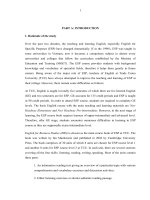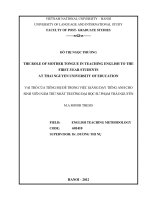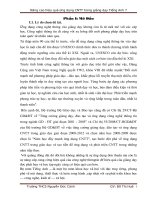Bài giảng môn Phương pháp giảng dạy tiếng Anh: Chapter 10 - Phan Thị Thu Nga
Bạn đang xem bản rút gọn của tài liệu. Xem và tải ngay bản đầy đủ của tài liệu tại đây (101.2 KB, 8 trang )
Chapter 10:
How to teach listening
I. Reasons for teaching listening
Letting Ss hear different varieties & accents
e.g. American English, British English
dialects, accents, pronunciation &grammar
Helping Ss to acquire language subconsciously
Listening: a language skill
II. Kinds of listening
authentic ~ non-authentic material
Different kinds of tapes/ CDs
e.g. announcements, conversations,
telephone exchanges, lectures, plays,
news broadcasts, interviews, radio programs
Learners’ needs, levels & interests
determine kinds of listening materials & tasks
III. Special characteristics of listening
Speed of speaker the same for everybody
Informal spoken language has unique
features such as incomplete utterances
(Dinner?), hesitations (well, ummm, er…)
Other spoken factors: tone of voice,
intonations, rhythm & background noise
because of these special characteristics, Ss
must be well-prepared for listening
IV. Principles
Tape recorder as important as tape
Preparation: vital (teacher & Ss)
Once not enough
Ss: responding to content & language
Different stages different tasks
Good teachers exploiting listening texts
to the full
V. Listening sequences
Example
Example
Example
Example
1 (beginners)
2 (elementary learners)
3 (intermediate)
4(upper intermediate)
(Read these examples in the textbook –
page 99-108)
VI. Using video
Kinds of video learners’ levels &
interests
Advantages: richer; speakers can be
seen; their clothes, their body
movements, location & background
information
Problems: Ss’ less attention to what
they are hearing, uncritically & lazily
Techniques for videos
Playing the tape/VCD/DVD w/o sound
Playing but covering the picture
Freezing the picture
Dividing the class half (half the class face
the screen; the other half sit with the
backs to it; the ‘screen’ half describe the
visual images to the ‘wall’ half









